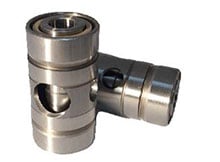Turbocharger Bearings

Turbocharger Bearings are mechanical components that facilitate the rotation of the turbocharger shaft. They are critical for turbocharging applications as they allow for high-speed performance and smooth operation of the turbocharger, which boosts the engine's power and efficiency.
Types of Turbocharger Bearings
Modern turbo bearing systems can be categorized into two types: hydrodynamic bearing systems and ball bearing systems.
Hydrodynamic systems use engine oil to lubricate and control shaft motion, with options for two fully floating journal bearings or a one-piece semi-floating bearing. Thrust bearings are also incorporated for axial control.
Ball bearing systems combine journal and thrust bearings for improved performance, with reduced clearances and lower power losses.
| Photo | Part Number | Bore Dia | Outer Dia | Width | Ring Material | Ball Material | Cage Material | Max Speed (RPM) | Temperature Range | Application |
|---|---|---|---|---|---|---|---|---|---|---|
 |
LILYTB005 | 6mm | 18mm | 34.20mm | M50 Steel | SAINT-GOBAIN Ceramic Balls | PEEK / Brass / Metel | 150000 | -60 to 600 ℃ | GT17,GT20,GT25 |
 |
LILYTB001 | 8mm | 22mm | 53.73mm | M50 Steel | SAINT-GOBAIN Ceramic Balls | PEEK / Brass / Metel | 150000 | -60 to 600 ℃ | GT25R.28R.30R.35R GT28,GT30,GT35 |
 |
LILYTB002 | 8mm | 22mm | 42.50mm | M50 Steel | SAINT-GOBAIN Ceramic Balls | PEEK / Brass / Metel | 150000 | -60 to 600 ℃ | GT25R.28R.30R.35R |
 |
LILYTB003 | 8mm | 22mm | 49.23mm | M50 Steel | SAINT-GOBAIN Ceramic Balls | PEEK / Brass / Metel | 150000 | -60 to 600 ℃ | GT25R.28R.30R.35R |
 |
LILYTB007 | 8mm | 22mm | 41.95mm | M50 Steel | SAINT-GOBAIN Ceramic Balls | PEEK / Brass / Metel | 150000 | -60 to 600 ℃ | GT25R,GT28R,GT30R,GT35R |
 |
LILYTB004 | 10mm | 28mm | 55.20mm | M50 Steel | SAINT-GOBAIN Ceramic Balls | PEEK / Brass / Metel | 150000 | -60 to 600 ℃ | GT/GTX37/40 GT/GTX42/45 GT37,GT40,GT42,GT45 |
 |
LILYTB008 | 10mm | 28.2mm | 44.55mm | M50 Steel | SAINT-GOBAIN Ceramic Balls | PEEK / Brass / Metel | 100000 | -60 to 600 ℃ | GTX37,GTX40,GTX42,GTX45 |
 |
LILYTB006 | 13mm | 34.8mm | 64.08mm | M50 Steel | SAINT-GOBAIN Ceramic Balls | PEEK / Brass / Metel | 100000 | -60 to 600 ℃ | GT42,GT45 |
Material of Turbocharger Bearings
Turbocharger Bearings are typically made of high-quality materials such as steel, ceramics, and composites.
- Steel turbocharger bearings: designed to withstand high speeds, high temperatures, and high thrust loads, ensuring optimal performance and reliability in turbocharged engines. They are cost-effective and widely used.
- Ceramic turbocharger bearings: offer higher speed capabilities, high-temperature resistance, and durability. For instance, ceramic Turbocharger Ball Bearings are high-speed angular contact bearings made with ceramic balls, cages, anti-rotation devices, and other components. They rotate up to six times faster than standard vehicle bearings and can withstand temperatures of up to 400 degrees Centigrade during hot shutdowns. These bearings are designed to be cooled by lubricating oil flow and are built to resist extreme conditions throughout the turbocharger's lifespan, making them ideal for high-performance applications.
- Composites turbocharger bearings: made from a combination of materials such as carbon fiber, ceramic, and polymers, improving efficiency and reliability in modern engines.
Structure & Design Considerations of Turbocharger Bearings
Turbocharger Bearings are typically composed of multiple components, including balls or rollers, cages, inner and outer rings, anti-rotation devices, and lubrication systems. These components work together to provide smooth rotation, minimize friction, and withstand extreme conditions in turbocharging applications.
Turbocharger bearings must tolerate high thrust loads, oil contaminants, oil supply delays, and hot shutdowns. Reducing bearing friction is vital for improving emissions and fuel economy, especially with lower viscosity oils and increased use of engine emission controls. Bearing systems must adapt for rotor-dynamic stability and prevent increased wear in modern engines.
Key Features of Turbocharger Bearings
- High-Speed Performance: typically up to 150,000 rpm or higher, depending on the specific application
- High-Temperature Resistance: withstanding temperatures of up to 400 degrees Celsius or higher in hot shutdown conditions
- Low Friction and Energy Efficiency: reducing energy losses and improve overall energy efficiency
- Durability and Reliability: bearings made of ceramics such as silicon nitride or zirconia can withstand the demanding operating conditions of turbochargers.
How to Choose Turbocharger Bearings
Selecting the right Turbocharger Bearings is vital for achieving optimal performance. Good turbocharger Bearings provide:
- High load carrying capacity for heavy rotating parts.
- Smooth operation in challenging and extreme conditions, such as rolling/pitching/yawing or extreme weather.
- Enhanced operational reliability, even during long-running hours or when oil is contaminated.
- Ability to withstand temperature peaks during engine startup or sudden stops.
- Non-reactivity with lubricating oil or other turbocharger parts made from different materials.
- Capability to handle high thrust loads, especially in variable geometry turbines.
- Tolerance to oil supply delay, as some turbochargers lack dedicated oil sump and supply pump.
Applications of Turbocharger Bearings
Turbocharger Bearings are widely used in various applications, including:
- Automotive Industry: Turbocharger Bearings are critical components in turbocharged engines used in passenger vehicles, commercial vehicles, and high-performance sports cars, offering improved performance and fuel efficiency.
- Industrial Applications: Turbocharger Bearings are also used in industrial applications such as power generation, marine, and aerospace industries, where high-speed performance and reliability are crucial.
Conclusion
Turbocharger Bearings are critical components in modern turbocharged engines, enabling high-speed performance, improved efficiency, and increased power. They provide support and damping to control radial and axial motion of the shaft and wheels, isolate vibration from rotating parts, enable high-speed spinning of turbo wheels, ensure efficient energy transfer from engine exhaust gas, work effectively with modern oils to reduce friction and power losses, and withstand higher engine oil temperatures of today's engines.


